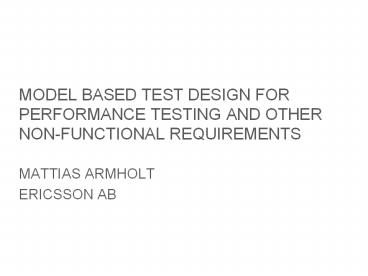MODEL BASED TEST DESIGN FOR PERFORMANCE TESTING AND OTHER NON-FUNCTIONAL REQUIREMENTS - PowerPoint PPT Presentation
Title:
MODEL BASED TEST DESIGN FOR PERFORMANCE TESTING AND OTHER NON-FUNCTIONAL REQUIREMENTS
Description:
NON-FUNCTIONAL REQUIREMENTS MATTIAS ARMHOLT ERICSSON AB Agenda Introduction Model Design Techniques Conclusions Model Based Test Design for Performance Testing and ... – PowerPoint PPT presentation
Number of Views:184
Avg rating:3.0/5.0
Title: MODEL BASED TEST DESIGN FOR PERFORMANCE TESTING AND OTHER NON-FUNCTIONAL REQUIREMENTS
1
MODEL BASED TEST DESIGN FOR PERFORMANCE TESTING
AND OTHER NON-FUNCTIONAL REQUIREMENTS
- MATTIAS ARMHOLT
- ERICSSON AB
2
Agenda
Introduction
Model Based Test Design for Performance
Testingand other Non-Functional Requirements
Model Design Techniques
Conclusions
3
Introduction
- My work
- Function tester at Ericsson AB
- Testing IP functionality in a middleware platform
- Working with MBT and automation for 3 years
- Environment
- Conformiq Modeler Model Design
- Conformiq Designer Test generator
- Java and TCL/Expect Test automation framework
4
Test models
5
Workflow
Test documentation
Test Management tool
Test results
6
Non-Functional Requirements (NFR)
- Capacity
- Performance Requirements
- Response time
- Throughput
- Processor-utilization
- Interoperability
- IP Standards
- Robustness
- Stability
- And more
7
Problems With NFR
- Lookahead depth
- Tool algorithm do not want to repeat the same
transitions multiple times without fulfilling new
requirements or covering new states/transitions. - Parametersation
- Requirements need transitions with several
parameters to fire many times. - The number of parameter combinations becomes
unable to handle. - Would generate thousands of test cases.
100 times
3 param
5 param
8
Problems With NFR
- Robustness/Stability
- Nothing new should happen during test
- Measurements
- No transition available in SUT for measurements
- Capacity
- No clear boundary value to test with.
? times
9
Method For MBT Of NFR
- Group the Non-Functional requirements based on
similarities - Evaluate if the group is possible to include in
the model - Design a test model including non-functional
requirements - Generate Test Cases
10
NFR Testability
- NFR requirements logic can be included in the
test harness/environment - Use test applications for iterations
- External equipment for interoperability
- Add functionality to test harness
- Increase SUT testability with test commands
- Testability is one criteria for MBT of NFR
11
NFR Test Logic Support
ITERATIONS
MBT MODEL
MANUALINSTRUCTIONS
STABILITY
TEST HARNESS
PERFORMANCE
TEST APP
SUT
TEST EQUIPMENT
12
NFR Model Design Techniques
- Design the non-functional requirements in the
model with - Requirement keyword
- Ad hoc requirements
- States
- Transitions
- Parameters
13
NFR Model Design Techniques
- Group iterations together
- Dont create 1 host 100 times, create 100 hosts
at 1 time - Removes risk of parametersation and lookahead
depth - Reduces test case length makes it easier to read
- Add logic in test harness or test environment
14
NFR Model Design Techniques
15
NFR Model Design Techniques
- Use different abstraction levels
- Focus the transitions to the parameters that
counts for NFR - Use precondition when modeling NFR
- Reduces the risk of unnecessary parameter
combination testing
16
NFR Model Design Techniques
MODEL PARAMETER
17
Conclusions
- In order to develop a good model covering
non-functional requirements, you need to practice
and learn how the tool generate test cases - Support for testing of NFR must be possible to
include in the test harness or test environment - In general NFR increases logic and complexity in
test harness and test environment
18
Conclusions
- Model cost of NFR the same compared to functional
requirements - Test harness/environment support development for
NFR cost more compared to functional requirements - Most valuable when NFR and functional
requirements are modeled together - Gain maintenance cost by MBT for all requirements
- Cost less to maintain model test harness
compared to separate test scripts
19
(No Transcript)






























